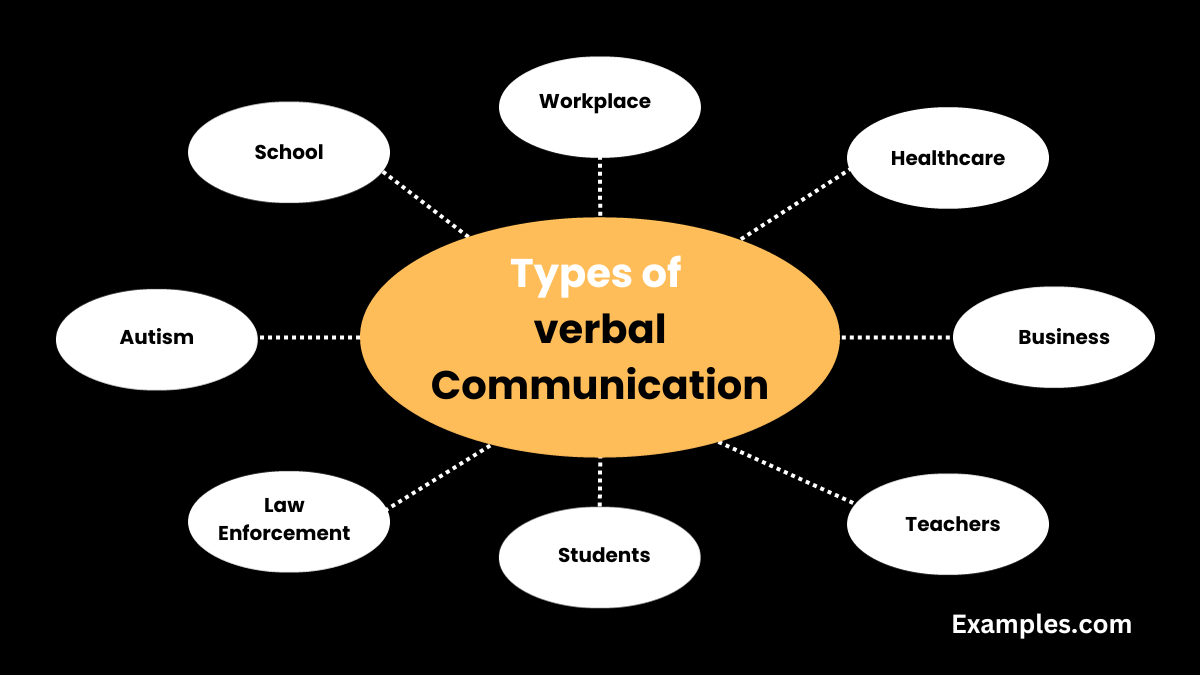Types of Verbal Communication – Examples, Types
Dive into the diverse world of expression with our complete guide on Types of Verbal Communication. From casual chats to formal presentations, understand how each form impacts interaction through real-life Communication Examples. This guide will help you identify and utilize various types effectively, enhancing your personal and professional relationships. Learn to navigate different scenarios with confidence and clarity, leveraging the right type of verbal communication for every occasion.
Download Types of Verbal Communication with Examples
Types of Verbal Communication

Verbal communication encompasses a range of techniques and styles, each serving different functions and purposes in human interaction. It’s said that a significant What Percent of Communication is Verbal?, highlighting the importance of mastering these skills. Various Verbal Communication Techniques include storytelling, active listening, and persuasive speaking, each offering distinct advantages and disadvantages. The effectiveness of verbal communication lies in understanding the Functions of Verbal Communication, such as expressing emotions, exchanging information, and influencing others. Developing robust Verbal Communication Skills is essential for personal and professional success. Recognizing the Advantages and Disadvantages of Verbal Communication allows individuals to adapt their style and technique to different situations. Continuous learning and adaptation are key, and there are many Ways to Improve Verbal Communication Skills, from seeking feedback to engaging in regular practice. By exploring different Verbal Communication Examples, one can become more adept and versatile in conveying messages effectively.
Verbal Communication in the Workplace
Verbal Communication in the Workplace is essential for effective collaboration, decision-making, and relationship-building among colleagues. Clear and concise verbal exchanges enhance team dynamics and productivity. To optimize workplace interactions, it’s important to continually learn How to Improve Verbal Communication Skills, such as practicing active listening, giving constructive feedback, and adapting communication styles to different audiences for better understanding and engagement.
Verbal Communication in Healthcare
Verbal Communication in Healthcare is vital for ensuring accurate patient care and effective team coordination. Clear and empathetic dialogue between healthcare providers and patients is crucial. It facilitates accurate diagnoses, treatment plans, and patient understanding. Why you need Verbal Communication Skills in this setting is clear: it directly impacts patient safety, satisfaction, and healthcare outcomes, making it an indispensable skill in the medical field.
Verbal Communication in Business
Verbal Communication in Business is vital for negotiations, decision-making, and leadership. It facilitates clear and effective exchanges between colleagues, clients, and stakeholders. Understanding the Importance of Verbal Communication is crucial for businesses as it directly impacts team cohesion, customer relationships, and overall success. Effective verbal communication ensures that ideas are conveyed clearly, feedback is constructively given and received, and organizational goals are achieved through collaborative effort.
Verbal Communication for Teachers
Verbal Communication for Teachers is fundamental in fostering a conducive learning environment. Teachers must master the art of delivering clear, engaging, and appropriate instructions while adhering to the Rules of Verbal Communication. This involves using a tone that is authoritative yet approachable, providing constructive feedback, and encouraging open dialogue. Effective verbal communication enables teachers to not only impart knowledge but also inspire and motivate their students.
Verbal Communication for Students
Verbal Communication for Students is crucial in educational settings as it directly impacts learning and collaboration. Unlike Verbal vs Written Communication, verbal interaction offers immediate feedback and personal engagement, essential for understanding and adapting to new information. Developing these skills helps students articulate thoughts, ask questions effectively, and actively participate in discussions, preparing them for academic success and future career challenges. Encouraging verbal expression is key to building confident and competent communicators.
Verbal Communication in Law Enforcement
Verbal Communication in Law Enforcement is crucial for maintaining public safety and effective policing. Officers rely on clear, concise verbal and oral communication to deescalate situations, gather information, and coordinate responses. Understanding the nuances between Verbal vs Oral Communication—where verbal includes all forms of words used, and oral is strictly spoken word—is essential in law enforcement settings for precise, controlled, and respectful interactions with the community and colleagues.
Verbal Communication for Autism
Verbal Communication for Autism involves tailored strategies to enhance understanding and expression for those on the autism spectrum. It focuses on simplifying language, using clear and concise sentences, and often incorporates visual aids to support understanding. Patience and repetition are key, as individuals with autism may require more time to process and respond to verbal cues. This approach emphasizes a supportive and adaptive communication environment, catering to the unique needs of each individual.
Verbal Communication for School
Verbal Communication for School is fundamental, shaping students’ academic and social development. It involves daily interactions, classroom discussions, and presentations, enhancing learning and collaboration. Effective verbal communication skills enable students to express their ideas clearly, engage in meaningful dialogue with peers and educators, and contribute to a vibrant school community. Encouraging these skills is crucial for fostering an environment of respect, understanding, and educational excellence in schools.
In conclusion, addressing the lack of communication requires understanding its examples and effects. Recognizing the signs early and undergoing effective Communication Training can drastically improve the Communication Process. To fix these gaps, one must be committed to continual learning and applying practical strategies, ensuring a more cohesive and effective exchange of ideas and information.



